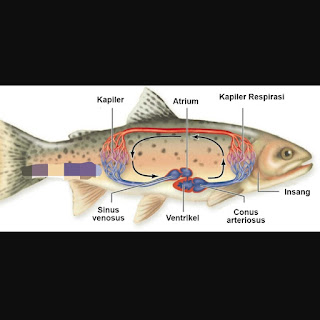Fish Circulatory System (Equipped with Pictures)
Fish are vertebrate animals that have a closed circulatory system and a single blood circulation. Definition of a single circulatory system is blood flow through the heart only once in one circulation. The fish circulation organ system consists of:
Fish Circulatory Organ System (credit: innerorgans.com)
Blood flow starts from the heart, then blood goes to the gills and gas exchange occurs. Furthermore, the blood will be drained by the dorsal aorta and then spread to all body organs through capillaries.
Blood from the entire body that contains a lot of carbon dioxide gas will flow into the sinus venosus which will then enter the atrium.
Sinus venosus is a room or cavity in the heart of the fish that is located between the ventricles and atrium. When the heart relaxes, blood will flow through the valve, then enter the ventricles. From the ventricles, blood will flow to the conus arteriosus, then to the ventral aorta and proceed to the gills. In the gill organs, the aorta will become capillary branches (small vessels).
The gill capillaries will release carbon dioxide gas and take oxygen from the water. In the gill capillaries blood will flow into the branched dorsal aorta. From these branches of the dorsal aorta blood will be spread to capillaries in all parts of the body of the fish which contain lots of oxygen and food substances to the cells of the body.
After that, the blood also takes carbon dioxide which is then taken back to the heart via the vena cava and sinus venosus.
- The heart is in the back of the gill arch. Parts of the heart of the fish consist of one atrium, one ventricle and sinus venosus.
- Conus Arteriosus
- Arteries
- Veins
- Capillary
Fish Circulation Mechanism
Fish Circulatory Organ System (credit: innerorgans.com)
Blood flow starts from the heart, then blood goes to the gills and gas exchange occurs. Furthermore, the blood will be drained by the dorsal aorta and then spread to all body organs through capillaries.
Blood from the entire body that contains a lot of carbon dioxide gas will flow into the sinus venosus which will then enter the atrium.
Sinus venosus is a room or cavity in the heart of the fish that is located between the ventricles and atrium. When the heart relaxes, blood will flow through the valve, then enter the ventricles. From the ventricles, blood will flow to the conus arteriosus, then to the ventral aorta and proceed to the gills. In the gill organs, the aorta will become capillary branches (small vessels).
The gill capillaries will release carbon dioxide gas and take oxygen from the water. In the gill capillaries blood will flow into the branched dorsal aorta. From these branches of the dorsal aorta blood will be spread to capillaries in all parts of the body of the fish which contain lots of oxygen and food substances to the cells of the body.
After that, the blood also takes carbon dioxide which is then taken back to the heart via the vena cava and sinus venosus.


Post a Comment